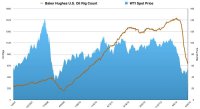Tilted
..
I just noticed that the price at the closest gas station to me is now $2.139, it was $2.079 (IIRC) a couple days ago.
Heating oil (i.e. off-road diesel) at that station is also up to $2.519 from $2.449 (IIRC) last week.
Now they're $2.499 (gas) and $2.799 (off-road).
There's a big disconnect between gas futures and oil futures right now. RBOB is at about $1.95 / gallon while WTI is at about $50 / barrel. Even Brent is only about $61 / barrel. Those barrel oil prices would typically be more in line with something like $1.60 gallon gas (RBOB) prices.



